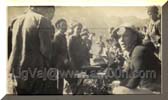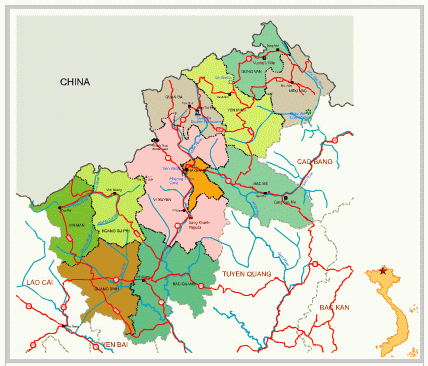 When Vaj Yis Tuam died, his brother Vaj Zoov Looj(Vương Chính Đức) was a secretary in the "Deer Party" and then replaced. When Vaj Yis Tuam died, his brother Vaj Zoov Looj(Vương Chính Đức) was a secretary in the "Deer Party" and then replaced. |
 Viet Nam was set under the rule of the French. The French employed Lord Bảo Lạc, set a path from Bảo Lạc, Cao Bằng province, occupied Đồng Văn. Viet Nam was set under the rule of the French. The French employed Lord Bảo Lạc, set a path from Bảo Lạc, Cao Bằng province, occupied Đồng Văn. |
Vương Chính Đức(Vaj Zoov Looj) led the Hmong in Đồng Văn to fight against the French for 10 years.
1909-1913Those rough policies reached the end of the line, Vaj Zoov Looj gathered the Hmong together, and the Hmong armament started the rebellion from 1909 to 1913. |
1910-1911Vaj Zoov Looj combined with Xyooj Miv Chaj force, a Hmong Hà Giang leader in Ma Lo mountain, in the fighting with the French. |
October 1913, the French-Hmong agreement was signed in Đồng Văn:
-Indochina Lieutenant-General Peregrin (?), represented the French government.
-Vương Chính Đức(Vaj Zoov Looj), represented Hmong.
| This is the end of the First Resistance of the Hmong against the French in Đồng Văn. |

1917Indochina Lieutenant-General announced: convened all Hmong clans's representatives to a meeting in Laos, on October 1918; to resolve French-Hmong matters. |
1918Accordingly, Indochina Hmong and Hmong in Southern Yun Nan-China mutinied against the French:- Yaj Paj Cai (Pa Chay) from Laos.- Haam Tuam Yawg from Mun Dong, Southern Yun Nan, China.- Vương Chính Đức (Vaj Zoov Looj, from Đồng Văn, Hà Giang, NorthEast Viet Nam.Altogether, they united at the same time to the outbreak. |
The French and Yun Nan province's ethnarch stood in with each other, ended the rebellion.
1921Yaj Paj Cai was arrested, The French delivered him up to the King of Laos, beheaded, threw his body off, and buried his head under the earthen tower in Luang Prabang, Laos. |
| Haam Tuam Yawg died in the battle, his children escaped, and their descendants are still in Yun Nan, China at the moment. |
| Vaj Zoov Looj was captured, and sent to Hoa Lo prison, in Ha Noi. |
1924In Đồng Văn, Hà Giang, Hmong movements continuously strive against Vaj Zoov Looj's arrest. French had to release Vaj Zoov Looj to soothe the case. |
1936Hmong in Đồng Văn attacked the French unsuccessfully. |
1938Vương Chính Đức(Vaj Zoov Looj) was captured again in Ha Noi. |
Vương Chí Sình(Vaj Txiaj Lwm) went to Ha Noi and managed to rescue his father.
| Vaj Txiaj Lwm joined a Horse Race, won a bet at 1,000 piastre Indochina currency (at that time, 1 Dong = 60kg rice), and met Demongpera (?name?), the Racing Horse's boss. |
| Demongpera invited Vaj Txiaj Lwm home and promised to help get Vaj Zoov Looj out of prison with the first charge of 800 piastre. |
| One month later, Demongpera gave Vaj Txiaj Lwm a release of Vaj Zoov Looj with conditions. |
 Vaj Zoov Lung was paroled: Cancel Hmong self-government in Đồng Văn, Hà Giang; And impounded the Hmong office turning into a French resident school. Vaj Zoov Lung was paroled: Cancel Hmong self-government in Đồng Văn, Hà Giang; And impounded the Hmong office turning into a French resident school. |
World War II - 1941
| Sun Yat-Sen(孙中山) of Guo Min Dang(The Chinese Nationalist Party)'s force gained upon China-North Viet Nam's border. |
Guo Min Dang's force defeated the French, French withdrew.
Vương Chính Đức(Vaj Zoov Looj)'s troops defeated Guo Min Dang
Vương Chính Đức(Vaj Zoov Looj) invited the French back to Đồng Văn, laying a scheme of co-operating with the French to conquer Guo Min Dang force. French had the same idea, too.
Japanese landed in Indochina, and French-Hmong united against the Japanese.
 Coup d'état of the Japanese and French left the Hmong on their own and withdrew to China. Hmong in Đồng Văn made the fight with the Japanese on their own. Coup d'état of the Japanese and French left the Hmong on their own and withdrew to China. Hmong in Đồng Văn made the fight with the Japanese on their own. |
Lately, the general of Japanese troops signed an Agreement with Vương Chính Đức(Vaj Zoov Looj), the Hmong let them borrow ways for them to move forward to Yun Nan, China.
1. Hmong kept their self-governing.
2. The Japanese retreated out of the Hmong zone.
3. The Japanese compensated the Hmong for war fees in money and salt.
4. Whether or not, the Hmong mustn't intervene in Japanese operations outside of Hmong zones.
1945Japanese surrendered to the Allies in August 1945. August 25th, 1945, Bảo Đại, Vietnamese King, abdicated. |
September 2nd, 1945:The Communist Viet Minh, under Ho Chi Minh's leadership, asserted the independence of the Democratic Republic of Vietnam. |
From that moment on, not only our family but the history of the Hmong people in Vietnam also turned into a different aspect.Diversities and conflicts also happened within the clan and family members, due to in and outside factors and matters. The stories have continued to be told, not even less dramatic, by books, magazines, newspapers, those "historical witnesses" and of course, rumors, too.Please look at the collection of these news and articles on this website. For an official tale told by the clan's members for these controversies, there is a waiting time, not just now yet... |



